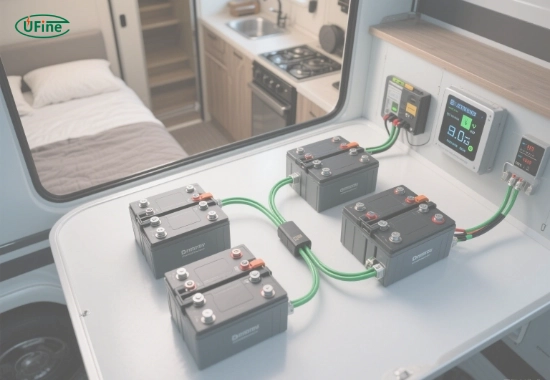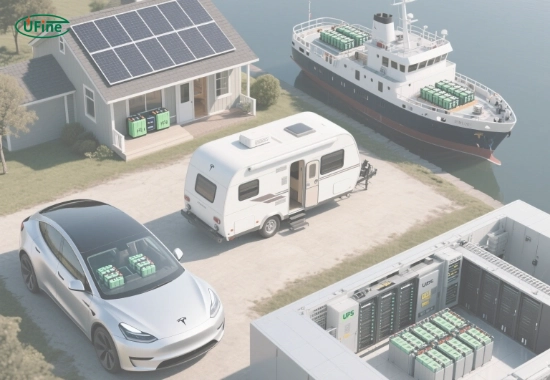A quadruple battery is a multi-unit energy storage system that integrates four batteries into a single, coordinated power source to deliver enhanced performance, efficiency, and reliability. This configuration is widely used in modern power systems due to the rising demand for scalable, high-capacity energy solutions. Whether you’re powering an electric vehicle, a solar array, or an industrial backup system, understanding how a quadruple battery works is essential for optimizing energy storage and usage.
In this guide, we explore the components, applications, advantages, design considerations, and maintenance practices of quadruple battery systems, giving you a complete understanding of why this configuration plays a critical role in today’s energy infrastructure.
Part 1. What is a quadruple battery?
A quadruple battery refers to a battery system made up of four interconnected battery units that work together as one. These four batteries can be connected in series (to increase voltage), in parallel (to increase capacity), or in a hybrid series-parallel configuration to optimize both.
Rather than relying on a single battery pack with limited capabilities, a quadruple battery system leverages the combined output of four units. These systems often have a Battery Management System (BMS) to monitor health, control charge cycles, and ensure safe operation.
Part 2. Why are quadruple batteries important in modern energy systems?
As energy demands increase across sectors—residential, commercial, transportation, and industrial—the need for flexible and scalable energy storage becomes more urgent. A quadruple battery setup provides several key advantages for modern systems:
- Scalability: Extra capacity or voltage can be achieved without redesigning the entire system.
- Modularity: Faulty units can be replaced individually.
- Redundancy: The system can continue operating even if one battery is underperforming.
- Improved performance: Load balancing reduces stress on individual batteries, extending overall lifespan.
- Energy efficiency: Integrated BMS ensures optimal charge/discharge behavior.
Part 3. How does a quadruple battery system work?
In a quadruple battery system, four batteries are connected with a configuration chosen based on the desired voltage and capacity. These are the three most common setups:
1. Series configuration
- Purpose: Increases voltage
- Example: 4 × 12V batteries = 48V system
- Application: Electric vehicles, high-voltage inverters
2. Parallel configuration
- Purpose: Increases capacity (amp-hours)
- Example: 4 × 100Ah batteries = 400Ah at 12V
- Application: Solar storage, off-grid homes
3. Series-parallel (hybrid)
- Purpose: Balances voltage and capacity
- Example: Two sets of 2 batteries in series, connected in parallel
- Application: RVs, marine systems, hybrid energy systems
A BMS (Battery Management System) is essential in all configurations. It ensures that each battery operates within safe voltage, temperature, and current ranges. The BMS also handles balancing, which keeps the batteries at the same charge level.
Part 4. What are the components of a quadruple battery system?
A well-designed quadruple battery system includes:
- Four matched batteries (same type, brand, capacity)
- Battery Management System (BMS)
- Wiring and connectors
- Fuses or circuit breakers
- Charging controller
- Monitoring display or dashboard
Each component plays a crucial role in maintaining performance and safety.
Part 5. Where are quadruple batteries commonly used?
Quadruple batteries are not just for tech geeks. They’re being used in places you’d never think about, including:
- Electric vehicles (EVs): Tesla and others often use multi-pack battery systems.
- Solar energy storage: Home and commercial solar systems use quadruple batteries to store more power.
- Recreational vehicles (RVs): More power means longer trips off-grid.
- Marine applications: Boats and ships rely on dependable marine batteries.
- UPS systems: Data centers use them to prevent power outages.
These systems need reliable, high-capacity energy, and that’s exactly what quadruple batteries provide.
Part 6. What are the advantages of quadruple battery systems?
✅ Enhanced capacity and voltage
By combining four batteries in different configurations, you can achieve the exact output needed for your system.
✅ Improved lifespan
The load is shared across batteries, which reduces wear and prolongs life, especially when paired with a smart BMS.
✅ System reliability
If one battery fails, the system may still function at reduced capacity.
✅ Flexibility in design
Whether you need more voltage or more runtime, you can adjust the configuration accordingly.
✅ Easier replacement and upgrades
You can replace a single battery instead of the whole pack, which saves cost and downtime.
Part 7. What are the challenges or downsides?
While quadruple batteries offer many advantages, they also come with a few challenges:
- Higher initial cost: Buying four batteries and a BMS isn’t cheap.
- Complex installation: Requires careful wiring, voltage matching, and safety precautions.
- Space requirements: Four batteries take up more physical space.
- Maintenance: More batteries mean more terminals, connections, and checks.
Part 8. What’s the difference between a quadruple battery and other battery types?
Let’s compare it to some common setups:
| Battery Type | No. of Units | Purpose | Flexibility | Capacity |
|---|---|---|---|---|
| Single Battery | 1 | Basic use (DIY, small tools) | Low | Limited |
| Dual Battery | 2 | Medium power setups | Medium | Moderate |
| Quadruple Battery | 4 | High-performance systems | High | High |
| Battery Bank | 5+ | Industrial or commercial use | Very High | Very High |
A quadruple battery is a sweet spot between power, cost, and flexibility. It’s more powerful than a dual system, but more manageable than a full battery bank.
Part 9. How do you balance batteries in a quadruple battery system?
Battery balancing is the process of ensuring that all four batteries in a system maintain the same state of charge (SOC). If one battery charges or discharges faster, it can cause performance issues or even damage the system.
🔧 Why is balancing important?
If one battery becomes overcharged or undercharged compared to others, it may:
- Reduce total system capacity
- Trigger safety shutdowns
- Cause overheating or swelling
- Shorten product lifespan
⚙️ Types of balancing methods
Passive balancing
This method uses resistors to dissipate excess energy from high-charge batteries as heat. It’s simple and commonly used in lower-cost systems.
Active balancing
This method uses capacitors or inductors to redistribute charge from higher-charged batteries to lower ones. It’s more efficient but also more expensive.
🔄 Balancing process (step-by-step)
- Monitoring: The BMS constantly checks the voltage levels of each battery.
- Detection: If one battery is out of balance, it’s flagged.
- Correction: Either excess energy is burned off (passive) or transferred (active).
- Equalization charge: Periodic full charging helps align all batteries.
- Repeat: This process runs continuously while the system is in use.
Best practices:
- Use a high-quality BMS with built-in balancing
- Never mix battery brands, capacities, and ages
- Regularly monitor battery health and temperature
- Perform a manual equalization charge every few months if the BMS doesn’t do it automatically
Part 10. How do you install a quadruple battery system?
For a safe and efficient setup:
- Use identical batteries: Same model, age, and charge level
- Plan your layout: Ensure proper ventilation and spacing
- Use heavy-duty cables: To handle high current
- Install a fuse or breaker on each battery line
- Label all cables and terminals to avoid confusion
- Secure the batteries: Prevent movement during transport or use
If you’re unsure, always consult a licensed electrician or system integrator.
Part 11. FAQs about a quadruple battery
How long does a quadruple battery system last?
With proper maintenance, most systems last 5 to 10 years. Lifespan depends on battery chemistry, usage cycles, and environmental conditions.
Can I mix different types or brands of batteries?
No. Always use identical batteries in terms of brand, capacity, chemistry, and age for best performance and safety.
Is a quadruple battery system suitable for home solar?
Absolutely. It provides more capacity and flexibility than single or dual systems, making it ideal for storing solar energy for nighttime or emergencies.
How often should I balance my batteries?
If your BMS supports auto-balancing, it will manage this continuously. Otherwise, perform a manual balance every 3–6 months.
What size inverter should I use with a quadruple battery?
That depends on your battery voltage and system load. For a 48V 400Ah system, a typical inverter is rated at 3,000W–5,000W. Always match the inverter to your total system output.
Related Tags:
More Articles

Why Lithium Weighing Machine Batteries Outperform Other Battery Types
Lithium weighing machine batteries outperform others with higher energy density, longer life, faster charging, and better reliability.
How to Choose the Best Food Scale Battery for Accuracy and Longevity?
Choosing the best food scale battery ensures precise readings, long life, and stable performance for home chefs and professionals alike.
The Ultimate Guide to Choosing the Right Ice Fishing Battery for Your Setup
Find the best ice fishing battery for your gear with this guide. Learn types, sizes, and tips to keep your setup running strong all winter.
Why Lithium Is the Best Battery for Ice Fishing: 7 Scientific Reasons
Lithium batteries excel in ice fishing with superior cold performance, longer life, and lighter weight with seven science-backed reasons explained.
How to Choose the Best Lithium Watch Battery for Your Timepiece?
Learn how to choose the best lithium watch battery to boost performance, ensure safety, and extend the life of your analog or digital timepiece.





